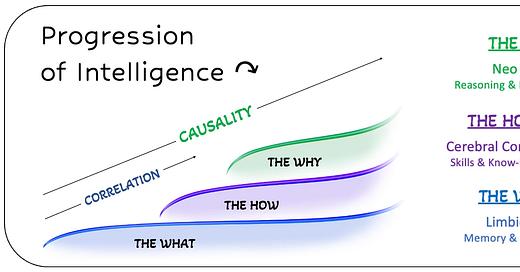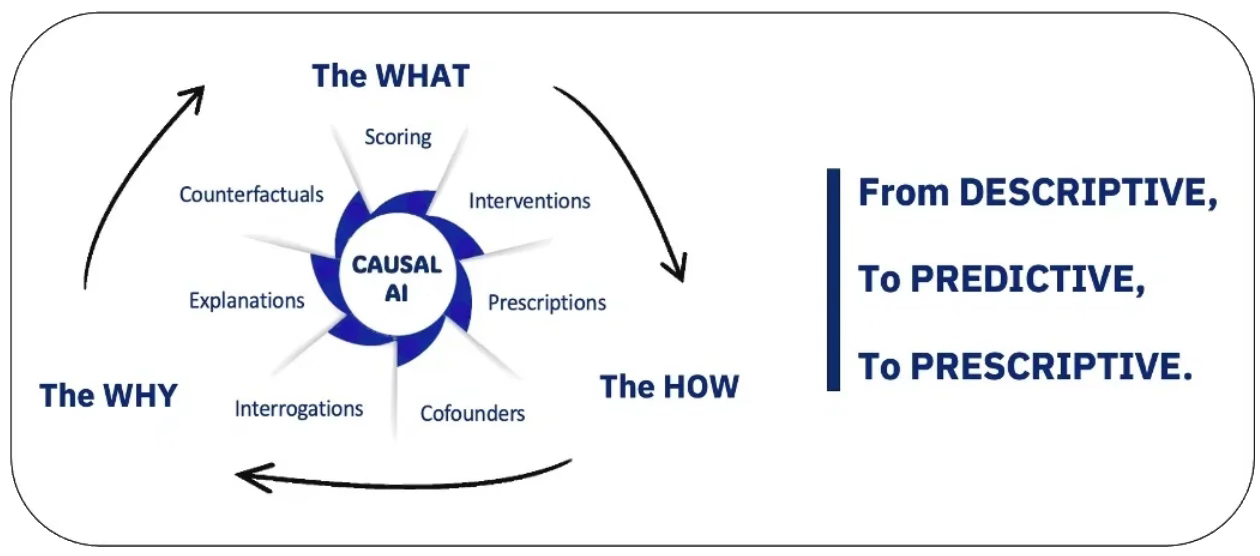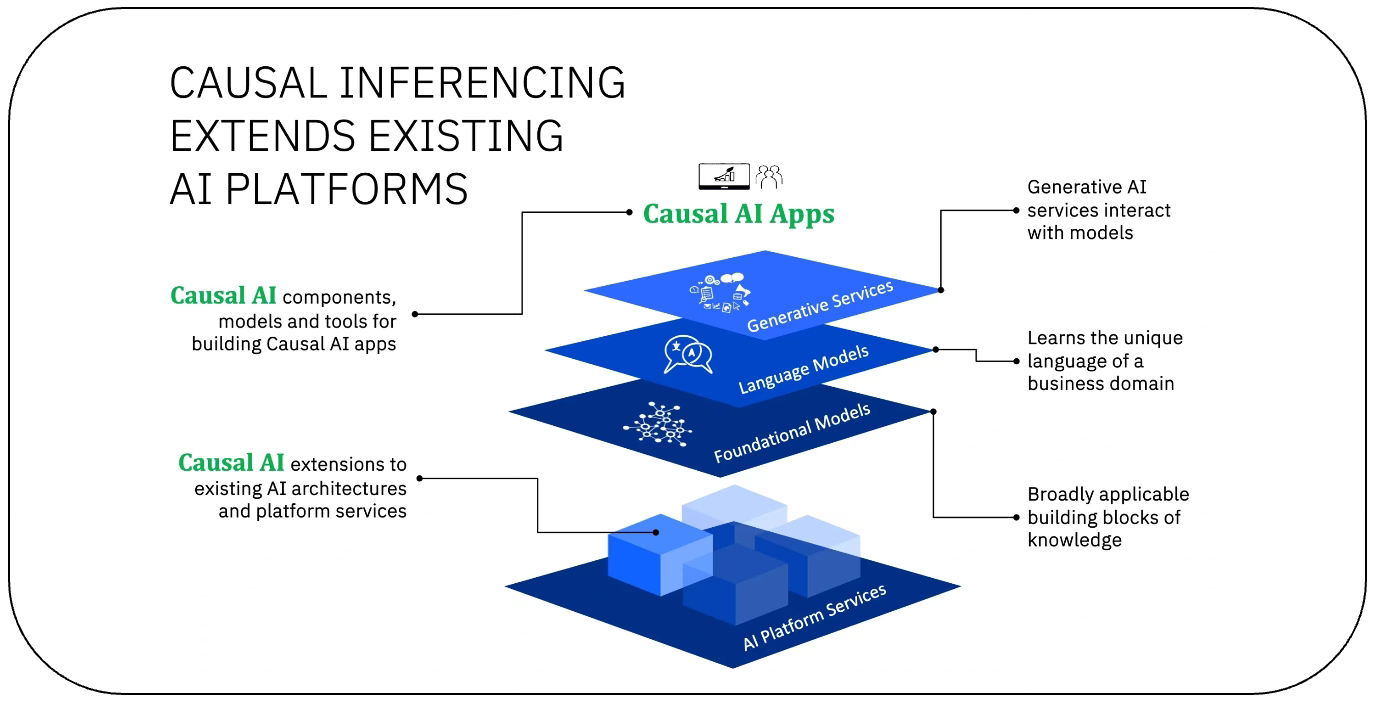Causality: The Missing Ingredient in Generative AI
Today’s generative AI capabilities are pretty impressive. But just wait until one of the most important MISSING INGREDIENTS gets added into the mix. This ingredient is what will make AI a truly indispensable partner in business.
The missing ingredient is CAUSALITY.
Causality will enable businesses to do more than just create predictions, generate content, identify patterns, and isolate anomalies. They’ll also be able to play out countless scenarios to understand the consequences of various actions, explain causal drivers of their business and collaboratively problem solve. They’ll know WHAT to do, HOW to do it and WHY certain actions are better than others – to more prescriptively shape future outcomes.
Causal AI is likely to become a “high” impact AI technology as indicated in the 2024 Gartner AI Hype Curve. And as a Databricks survey found, 6 in 10 plan to adopt it, making it the top future-state technology. Overall, its marketplace is projected 41% CAGR through 2030, nearly 2x traditional AI.
So, why is this such a big deal? Well, let's frame the role of causal reasoning by using an analogy to different functions of the human brain:
This analogy is right on! Simply put, humans are causal by nature, so AI also needs to become causal by nature. And, in turn, create a interactive experience between human and machine to collaboratively problem-solve.
As such, this article on Causal AI will explore:
The basics
The ingredients
The use cases
Finally, I’ll outline some CALLS TO ACTION for those interested in getting more involved in this highly impactful technology.
Read on and let me know what you think!
The Basics:
The methods upon which AI reasons is a function of its inferencing design – that is, how it progresses from a premise to logical consequences to judgements that are considered true based on other judgements known to be true. In essence, it must determine WHAT will happen, HOW it will happen and WHY it knows certain actions are better than others. This level of intelligence can only occur by fusing AI’s correlative powers with causality.
Let’s dive deeper, while making the analogy to the functions of the brain:
The WHAT – Today’s AI, including the LLMs / GenAI, derive their powers from correlating variables across datasets, telling us how much one changes when others change. They can deduct specific observations from generalized information or induce general observations from specific information. Auto-regressive designs also can describe random processes by identifying dependencies among variables and past values. LLMs are similar to the limbic brain which drives instinctive actions based on memories, making them good at automating tasks and creating content.
The HOW – Beyond predicting or generating an outcome (the “WHAT”), businesses also want to understand and explain how the outcome was produced. This requires advanced transformations that integrate correlative patterns, influential factors, neural paths and causal relationships (cause & effect) to de-code the “HOW”. Have you ever tried to explain something without invoking cause & effect? Think of this as playing the role of the cerebral cortex that encodes explicit memories into skills and tacit know-how. This is key to recommending prescriptive action paths that are trusted, transparent and explainable.
The WHY – For AI to truly reason and problem solve, it must understand precise “cause and effect” relationships. That is, understand the dynamics of “WHY” things happen, what can be done to change things, and the consequences of interventions. This requires a shift from today’s forward-progressive inferencing to bi-directional inferencing based on dynamic past conditions as a mechanism for exploring various “what-if” propositions. This mimics the neocortex which drives higher order reasoning such as decision-making, planning and perception. For AI that to collaborate with humans to problem solve, these powers are a must.
While there may be different degrees of implementation, causal AI is realized when it can deliver the capabilities above in an integrated manner - knowing the WHAT, the WHAT, and the WHY of business-critical problems.
The Ingredients:
No matter how sophisticated a predictive model is, it still only establishes a correlation between a behavior or event with an outcome. But that is very different than saying that the outcome happened because of the behavior or event. There can be correlation but not causation, and causation but not correlation. To make good decisions you need to understand root causes, as equating correlation with causation is an incubator for hallucinations & bias
Casual AI can identify precise cause & effect relationships, and thus root causes. This is critical as being able to describe and/or predict something is not as valuable as actually knowing what caused it and what can be done differently to improve an outcomes. Furthermore, the pathways through today’s neural networks are black boxes. They cannot tell you how variables in a network interacted, nor their values, nor how they influenced an outcome. So why should you trust it? How do you explain it?
Causal AI promises to uncover the causal pathways to an outcome. It can infer the relationship among variables in a dataset, and which variables influence each other and the outcome, and the extend of those influences. This allows progressive discovery of complex causal relationships that are ranked (scored) in terms of influence. The foundation of reasoning.
With Causal AI, businesses will gain an array of new AI “ingredients” (or tools) that are simply not available in today’s generative AI solutions:
Intervention: why certain actions are better than others (“what-if”)
Consequence: impact on metrics (KPIs) of alternate actions paths
Counterfactuals: evaluate alternatives to the current factual state
Confounders: identify irrelevant, misleading or unknown influences
Prescriptions: interrelated actions (pathways) to a desired outcome
Explanations: how and why a prediction or outcome was generated
Interrogations: infuse human knowledge, policy, and constraints
By adding these new “ingredients” into the mix of today’s AI, businesses will gain the ability to play out countless scenarios, understand how actions impact the business, and confidently pursue the path to optimal outcomes.
Furthermore, they break open the “black box” of today’s AI models to gain fully explainability and transparency which is critical to establishing trust, eliminating bias, and managing compliance mandates.
In the end, seven key features of causal AI will finally enable humans and machine to collaboratively reason to solve complex challenges, progressing from descriptive --> to predictive --> to prescriptive decision-making.
The Use Cases:
The use cases are truly limitless, as “cause & effect” is the foundation of decision intelligence, automation and strategic planning.
To illustrate, here are some real-world examples of causal questions:
Marketing: what is the best mix of tactics, spend, and offers to drive KPIs?
Customer Churn: why are we losing clients in certain regional markets?
Pricing: how do we best configure an elastic pricing model?
Supply chain: what are root causes of inefficiencies and how do we fix?
Manufacturing: is inventory management a source of product failures?
Legal Strategy: what is the most legally sound mix of cited case law?
Financial: how will various fed rate cut strategies impact the S&P 500?
HR: how does various retail store staffing model impact revenue?
Regulatory: explain why we made more risky investments?
And, to bring it all together, a real-life marketing challenge in retail:
Calls-to-Action:
While today’s correlation-based is good for descriptive and predictive analytics, it lacks prescriptive reasoning and know-how to solve more complex challenge. And since causal AI extends existing AI platforms, it makes it cost-effective to explore how it can impact your business.
It's my view that the advent of Causal AI is inevitable and its time to:
(1) Explore the world of causal AI
(2) Create a future-state PoV and use case strategy
(3) Gain a hands-on experience & certification
(5) Connect to industry experts to understand real-world
Visit my HebnerAdvisories.ai/causal-AI for more information and feel free to contact me on the website, here or via LinkedIn.












